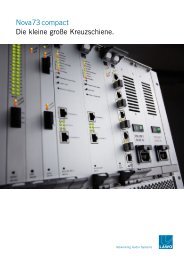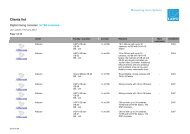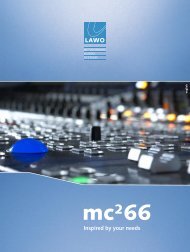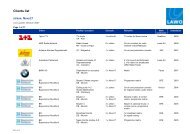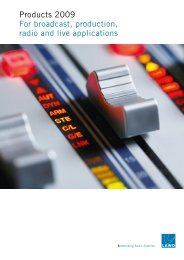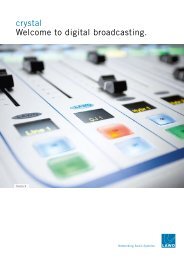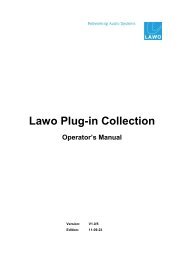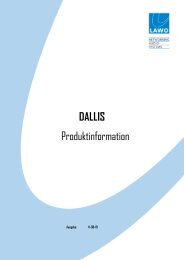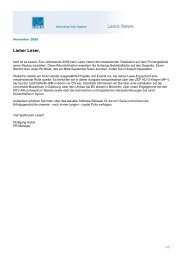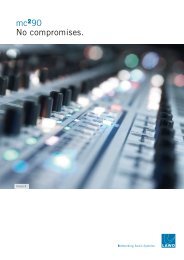Brochure mc²56 - SLG Broadcast AG
Brochure mc²56 - SLG Broadcast AG
Brochure mc²56 - SLG Broadcast AG
Create successful ePaper yourself
Turn your PDF publications into a flip-book with our unique Google optimized e-Paper software.
<strong>mc²56</strong> — Performance, pure and simple.<br />
All good things come in threes:<br />
The <strong>mc²56</strong> system elements.<br />
The <strong>mc²56</strong> system is based on three main elements:<br />
1 Mixing console control surface<br />
2 DSP and routing matrix (HD core)<br />
with integral control system<br />
3 DALLIS I/O interfaces<br />
The control surface and the HD core communicate via an<br />
optionally redundant Ethernet connection, while the DALLIS<br />
stage boxes are connected via multimode glass fibre. This<br />
enables the stage box units to be located up to 2 km from the<br />
core. An optional monomode connection facilitates distances of<br />
up to 8 km.<br />
The heart of all mc² consoles:<br />
The Lawo HD core.<br />
MADI<br />
1<br />
Ethernet,<br />
no Fibre ATM Line<br />
ATM<br />
3 3<br />
2<br />
Together with its integrated routing matrix, the mixing console<br />
provides the greatest possible flexibility in terms of I/O interfaces<br />
and DSP resources.<br />
The benefits are:<br />
Maximum of 8 DSP cards with up to 384 fully<br />
equipped DSP channels<br />
96 kHz operation<br />
Up to 144 summing buses<br />
MADI, ATM or AES connections directly to the core<br />
All conventional analogue or digital I/O and control interfaces<br />
via DALLIS<br />
Transformer microphone cards of the highest quality for<br />
critical music audio<br />
Routing matrix capacity 8192 x 8192 mono channels<br />
Hi-Tech for Hi-Fidelity:<br />
Audio processing.<br />
Audio processing takes place on DSP cards<br />
within the HD core. The core can operate<br />
at 48 or 96 kHz sampling frequency, with<br />
40-bit floating point processing, so that<br />
an internal dynamic range of 1000 dB is<br />
available.<br />
Should a DSP card fail, a redundant DSP<br />
card takes over all the crosspoints and<br />
DSP parameters within a few milliseconds.<br />
High quality algorithms ensure the finest<br />
audio processing. All DSP settings are<br />
interference-free, so that even delay settings<br />
can be made without interruption,<br />
even during runtime.<br />
All audio modules such as input mixing,<br />
filters, EQ, dynamics, delay, stereo image<br />
and surround panning are available on<br />
up to 384 fully equipped DSP channels.<br />
In addition, 32 Aux/Send feeds can be<br />
sourced from every channel.<br />
10 11<br />
Different DSP configurations enable the<br />
organisation of DSP resources according<br />
to different production requirements.<br />
Configuration changes are possible at any<br />
time during runtime, without production<br />
data being lost, or unpleasant artefacts.<br />
Even the parameters on channels that are<br />
no longer available will continue to be<br />
saved. This means that all your settings<br />
remain intact in the case of a renewed<br />
change to the DSP configuration.<br />
Surround channel with hyper-panning.<br />
What sounds good can now be particularly simple to operate. For example, you can<br />
control surround ‘bundles’ with one fader that links all channel parameters and<br />
8-channel metering. Lawo hyper-panning makes it possible to turn a surround bundle<br />
through 360°, where front width, back width and depth determine the surround source.<br />
A further benefit: a mono or stereo source positioned within a surround image can be positioned<br />
using a single control. The Reveal function opens a surround bundle onto up to<br />
eight faders, enabling direct access to all the offsets of individual channel parameters.



